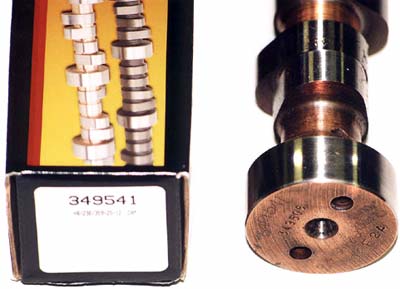
 Camshaft
duration is one of the major keys in producing
torque and throttle response in your engine.
The duration of the cam at 0.050" tappet lift
is the key. Many cam grinders take different
approaches to measuring advertised duration
figures. The best bet is to compare the grinds
at 0.050," and then begin to assess the other
features of the cam. Cam lift is important too.
In today's camshaft arena, the trend is to lift
the valve quicker and higher, then settle the
lifter down gently. Camshaft
duration is one of the major keys in producing
torque and throttle response in your engine.
The duration of the cam at 0.050" tappet lift
is the key. Many cam grinders take different
approaches to measuring advertised duration
figures. The best bet is to compare the grinds
at 0.050," and then begin to assess the other
features of the cam. Cam lift is important too.
In today's camshaft arena, the trend is to lift
the valve quicker and higher, then settle the
lifter down gently.
While on the topic of long duration figures, it is not completely impossible to make a long duration cam work -- especially in an application that might see limited street use. In order to make use of long duration figures in certain combinations, the camshaft overlap can be decreased. This is made possible by increasing the camshaft lobe center (remember, this can only be done during cam construction). Spreading the camshaft lobe centers actually decreases overlap measurably and you might be able to use more duration that you had thought possible. Spreading the lobe centers does influence idle and part throttle driveability by a significant amount in some applications, but it does come with other added "costs". These "costs" include a reduction in top end breathing capability. With the lobe centers spread apart, overlap decreases and the engine loses a portion of its scavenging ability. In simple terms, the engine runs out of breath on the top end, but throttle response, mid range power and idle quality are retained.
When camshaft lobe centers are reduced, the
engine tends to become peaky in power output,
but there's a caveat here too. If the engine
has a long stroke, and small intake port (volume),
high flow heads, then there's a good chance
the "peakiness" is a moot point. An engine that
is "peaky" simply means that it will develop
good power at a specific rpm range, but will
become quite lazy in another. This is where
the overlap question re-enters the picture.
A combination of tight lobe center angles and
long duration numbers produces a relatively
large overlap figure. As a result, the power
band is tightened. Certain road race applications
respond favorably to this type of camshaft,
but keep in mind that road racing almost always
involves gearing the vehicle (transmission and
rear axle ratios) to the specific racetrack.
High rpm, stick shift, lightweight drag race
cars can also make use of this type of camshaft,
but even in the specialized worlds of racing,
the applications are quite limited. 
Stay Tuned! Part 2 of "CAM-ROD-ERY"
coming soon!
| Special
thanks to Crane Cams for the preparation
of this article. Crane Cams can be reached
at: |
Crane
Cams
530 Fentress Boulevard
Daytona Beach, FL 32114
PH# 904-258-6174 Fax# 904-258-6167
|
| The
following companies also offer custom camshafts
for countless high performance applications:
|
Competition
Cams
3406 Democrat Road
Memphis, TN 38118
PH# 901-795-2400 |
Crower
Cams
3333 Main Street
Chula Vista, CA 91911-5899
PH# 619-422-1191 |
Erson
Cams
550 Mallory Way
Carson City, NV 89701-5374
PH# 702-882-6600 |
Isky
Racing Cams
16020 S. Broadway Street
Gardena, CA 90247
PH# 213-770-0930 |
Lunati
P.O. Box 18021
Memphis, TN 38181-0021
PH# 901-365-0950 |

|